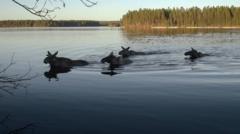Every spring for the past six years, a unique livestreaming event called "The Great Moose Migration" has drawn millions of viewers, eager to witness the incredible journey of elk in northern Sweden. This captivating broadcast tracks the majestic animals as they swim across the Angerman River, heading towards lush summer pastures.
Kicking off on Tuesday, a week earlier than anticipated due to unusually warm weather in April, this year's 24-hour program launched on SVT Play, the streaming service of Sweden's national broadcaster. The concept has become a phenomenon in the "slow TV" genre, cultivating a steady and enthusiastic viewership since its debut in 2019.
Cait Borjesson, 60, a dedicated viewer since discovering the stream during the Covid-19 pandemic, expressed her delight at being able to immerse herself in the broadcast. "It’s unbelievably relaxing," she shared, having kept her TV tuned into the migration for 16 consecutive hours. For Cait, following the migration has become an annual ritual, so important that she takes time off work to enjoy the three-week event. She likens the experience to therapy, benefiting her anxiety and panic attacks.
The livestream enjoys immense popularity, highlighted by a Facebook group with over 77,000 members, where fans exchange memorable moments and emotional responses to the captivating scenes. A significant part of the elk's journey is filmed in the village of Kullberg, nestled alongside the Angerman River. Interestingly, the animals known as moose in North America are referred to as elk in Europe.
Goran Ericsson, dean of the faculty of forest sciences at the Swedish University of Agricultural Sciences, explained that elk have been migrating since the ice age, returning to their summer ranges after gathering in areas with more favorable winter conditions. Approximately 95% of the elk in northern Sweden migrate each year, and while this year's migration was prompted by reduced snowfall, early migrations in spring are part of a natural cycle.
The event has captured the hearts of viewers, garnering nearly a million during its inaugural 2019 launch and ballooning to nine million viewers in 2024. Minh-Xuan Truong, a researcher at the Swedish University of Agricultural Sciences, remarked on the appeal of experiencing nature through this "slow TV" format, noting that many prefer the natural sounds of the forest over background music or commentary.
Sweden, home to around 300,000 elk, affectionately refers to these creatures as the "King of the Forest," celebrating their indelible place in the nation's natural landscape.






















